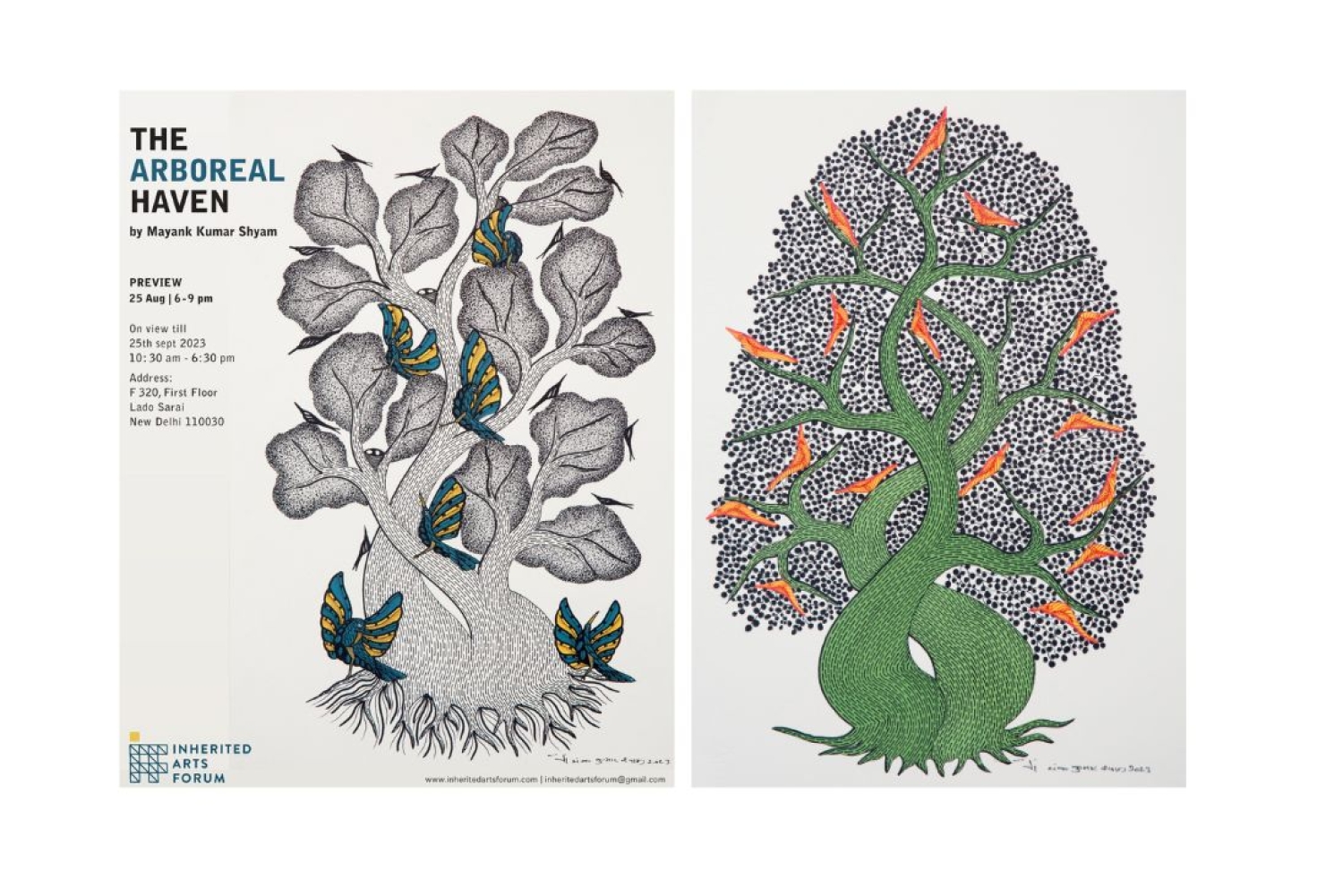

One of the most prominent tribal artists today, Mayank Kumar Shyam, was first introduced to the form of Gond Art in his early childhood because of his parents, who are also acclaimed artists. Through his art, Mayank reimagines oral tribal narratives, preserves them in art and brings forward the importance of nature in the Adivasi community. At his ongoing solo exhibition in the Inherited Arts Forum, his works are inspired by a profound story, where a bird and a tree offer care to each other and form a harmonious coexistence for their coming generations, blessed by the gods themselves. When I contacted him to know more, he tells me how elated he is to have a conversation. “We artists cannot show beauty in our words as much as we do in our paintings so it's important to talk to people like you."
Tell us about the relationship between birds and trees and what importance they hold in the Gond-Pardhan Community.
In the Gond-Pardhan Community, we pray to trees and look at them in the form of Devi and Devta. And the most prominent tale in our community is of a Dev who formed the tree. There was no earth at first, it was all just water. When Earth was first formed, a single hair of the Dev was pulled and planted on the soil, a tree took birth from his strand of hair. That’s why we pray to them. Another practice that isn’t prevalent anymore is that if a person dies, during the funeral procession, a plant would be sown on that land. When it grows, the plant is considered to be the soul of that person. That is what trees and plants mean to us.
About the relationship between plants and birds, I’ll tell you a beautiful story. Every day, on a tree, a bird used to come to sit with food. She used to feed the tree as well. One day the bird was crying, and the tree felt her tears and asked the bird about what happened. The bird says that she couldn’t find any food for two days. The tree prayed to God "How can I help the bird? I can’t even move but I have to help her in some way. Please tell me how." God blessed the tree that from this time onwards, you’ll also be able to bear fruits and flowers so that you can feed your friend. After some time, it led to a coexistence. The bird built her nest on the tree and gave birth to her children. She also ate the fruits and left the seeds on the ground which gave birth to other trees. It also gave birth to their mutual respect for each other and they taught the same to their coming generations as well.
Tell us about your journey and how you became an artist.
My father started the Gond art — he is known as the Godfather of this art. I used to hear and learn from his stories, opinions and his process. He and other Adivasi artists looked at Gods in terms of the nature. There are a lot of tales all over India, where forms of Gods would curse people if they get angry and there is a lot of fear attached to it. But they didn’t want to look at Gods through the lens of fear, they wanted to look at their beauty and thus, practised such an art form. Now, I look at my village from the stance of the city. I am interested in understanding my traditions, and the art, which are very deep and have innumerable meanings! My father always told me that I was not supposed to copy his art but catch the roots of it and make my own work.
What do you think of the representation of Adivasi artists in the urban art world?
Cities came into existence very late. Earlier, it was mostly jungle and life related to it. When Adivasis come into the urban world now, they don’t forget about their values related to trees. Trees are something through which we live our life and they are preserved in our tales. It is scientifically proven as well that through trees we get oxygen to breath, so its very important for us to preserve and respect them. When an Adivasi comes to the city, they tend to tell stories related to the environment and tries to create awareness about their importance in the urban world.
How did you manage to reinterpret these oral stories from your community into visual art? Tell us about your creative process.
There are two things. I listen and pay attention to these interesting stories. In the Adivasi traditions, stories were only oral, they weren’t written down like Vedic books that you can read. We have received these stories with a lot of filters. So, we have to keep these stories preserved in our artworks.
While I listen to these interesting stories, I also wonder that if these stories, that were formed by my ancestors, also had some sort of logic. Why were these stories formed? What is the connection of humans with these stories? Most of the artists, listen to the stories and make characters out of it. But I make characters that are filled with my imagination. So my work should be such that it follows the rhythm of a story but it also showcases the message. I mix the real with the imaginary.
Words Paridhi Badgotri
Date 11.09.2023